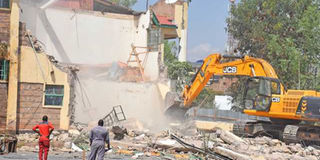Buildings to be torn down in new safety drive by State agencies

A building housing the Isiolo County Assembly is brought down to allow the construction of another with a 300-seater capacity at the public gallery. Locals accused authorities of wasting public money. PHOTO | FILE | NATION MEDIA GROUP
What you need to know:
- The State will also go for thousands of properties on riparian land.
- A report tabled in the National Assembly on Thursday afternoon shows that 14,895 buildings have already been audited.
- In Nairobi, the structures are found in Huruma, Pipeline, Umoja, Kariobangi, Kahawa West, Dagoretti, Baba Dogo, Mathare estates and on Thika Road.
Properties valued at billions of shillings are to be demolished in various parts of the country as the government cracks down on buildings deemed dangerous or unsafe.
The State will also go for thousands of properties on riparian land.
A report tabled in the National Assembly on Thursday afternoon shows that 14,895 buildings have already been audited.
Some 723 have been declared “very dangerous” and another 10,761 “unsafe”. The structures are awaiting integrity tests to pave the way for their pulling down.
100 BUILDINGS
“We have so far tested 100 buildings. Other structures are on riparian land, road reserves and Kenya Power and pipeline reserves. These structures are marked for removal,” says the October 16 report compiled by the Ministry of Transport, Infrastructure, Public Works, Housing and Urban Development signed by Principal Secretary Gordon Kihalangwa.
A majority of the “very dangerous” and “unsafe” buildings are in Nairobi, Kisii and Kiambu counties.
In Nairobi, the structures are found in Huruma, Pipeline, Umoja, Kariobangi, Kahawa West, Dagoretti, Baba Dogo, Mathare estates and on Thika Road.
In Kiambu, the buildings are found in Ruiru and Kiambu towns and their surroundings, the report adds.

Mukuru Kwa Njenga residents alerted city authorities on noticing cracks on this building still under construction. Authorities say the building will be demolished. PHOTO | SAMMY KIMATU | NATION MEDIA GROUP
In Kisii County, some 20 buildings are classified as “very dangerous” while another 671 are as unsafe for occupation.
Other unsafe and very dangerous buildings are to be found in Malindi, Kilifi County (11), Mombasa (7), Kitui (4), Nyahururu (3) and Kakamega (1).
The report rates “very dangerous” buildings as those that are structurally unsound, based on visual observation. These buildings need immediate action, including evacuation if they are already occupied.
STRUCTURAL INTEGRITY
The buildings will, however, require more tests to ascertain their structural integrity before they are demolished or given a clean bill of health.
The owners of unsafe buildings may get a reprieve if authorities order their rehabilitation.
According to the document, some 9,970 illegal structures – semi-permanent – have so far been removed from road, rail and power reserves and riparian lands.
The report indicates that 41 structures have been recorded as having collapsed and the cases are being handled by the Directorate of Criminal Investigations.
Following numerous cases of buildings collapsing, especially in the capital city, a multi-agency team was formed by President Uhuru Kenyatta to comprehensively audit structures in Nairobi and other parts of the country.
According to the report, Huruma estate leads the pack with 388 houses marked as very dangerous. It is followed by Thika Road, which has 100 such structures.
Pipeline comes third with 65 while Baba Dogo has 38 houses marked as dangerous. The report says there are 30 temporary and permanent structures on road reserves in Kibera, Githurai and Dandora.
DEMOLISHED
The committee was to, among other things, conduct a comprehensive audit of buildings and those found without necessary approvals be demolished immediately.
The ministry says it has put in place measures to ensure buildings are safe and certified by the relevant authorities before they are occupied.
Some of the measures include issuing the occupation certificate by devolved governments once buildings are completed and inspected, the regularisation of buildings that meet minimum habitable standards by county governments and sensitising the public on unsafe buildings and other structures.
The National Construction Authority has been conducting investigations on the possible causes of houses collapsing.
The authority says in cases where contractors are found to have flouted building regulations, they are suspended and removed from the agency roll.
“For the last one year or so, the NCA has been conducting an empirical study on cause of failure and collapse of some buildings and possible mitigation measures,” the report says.
INSPECTION
A 2019 draft Environment Bill, which envisages a review of the 1968 building code, standards and mandatory inspection is at the Cabinet approval stage.
Last month, eight Precious Talents School children died when their classroom collapsed. The Ministry of Education has since closed hundreds of private schools whose buildings are structurally unsound.
In June 2017, a six-storey building collapsed in Kware, Embakasi, killing at least three people.
One of the worst building tragedies occurred in Huruma in April 2016 when a structure collapsed during a dowpour, killing more than 40 people.





